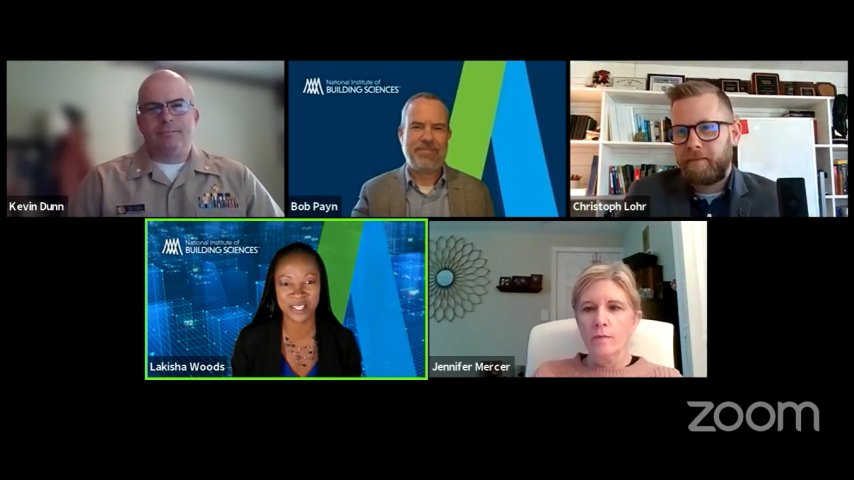
Because of COVID-19, many buildings have sat empty for the better part of a year, and there are possible health risks tied to the return of these unoccupied spaces.
On April 20, 2021, the National Institute of Building Sciences hosted a panel of experts to discuss how the building industry must recalibrate and adjust to a post-pandemic world. The webinar – How to Stay Safe as Lockdowns Lift and Buildings Reopen – was the third installment of the NIBS Resilience 2021 webinar series. It was sponsored by the Whole Building Design Guide and received more than 500 registrants.
Panelists included Lieutenant Commander Kevin Dunn, MS, Certified Industrial Hygienist with the Centers for Disease Control and Prevention/National Institute for Occupational Safety and Health (NIOSH); Christoph Lohr, PE, CPD, LEED AP BD+C, Vice President of Strategic Initiatives with the International Association of Plumbing and Mechanical Officials (IAPMO); Jennifer Mercer, National Co-op Sales and Marketing Manager with Facility Solutions Group; and Greg Walker, Senior Director of Research of Continental Automated Buildings Association (CABA). NIBS Senior Director of Information Technology Bob Payn served as moderator.
Reducing Exposure With a Layered Approach
The Centers for Disease Control and Prevention (CDC) reports the temporary shutdown or reduced operation of a building and reductions in normal water use can create hazards for returning occupants. These hazards include mold, Legionella (the cause of Legionnaires’ disease), and lead and copper contamination. The building industry must consider transformational initiatives to thrive beyond this pandemic.
Commander Kevin Dunn, with NIOSH, said the organization has been very active in the CDC’s response to COVID-19 over the past year and mentioned the CDC recommends a layered approach to reduce exposure to COVID-19 in the workplace.
In addition to individual measures like wearing face masks, physical distancing, and handwashing, this mitigation strategy includes checking and servicing HVAC systems, altering the physical layout of an office or work space, and adjusting the flow of personnel, products and customers.
LCDR Dunn mentioned several resources that could help businesses and building owners, including the CDC’s Resuming Business Toolkit, which covers things to consider before reopening physical spaces. These include how to perform hazard assessments, guidance for remediating moisture, mold and pests, and how to evaluate mechanical and water systems.
Other resources he mentioned included the American Industrial Hygiene Association and Building Owners and Managers Association (BOMA) International.
Plumbing Resiliency: A Holistic Mindset
The plumbing industry is going through a renaissance, says Christoph Lohr, with IAPMO.
The COVID crisis has elevated the concern of many in the plumbing industry.
“When you think about plumbing resiliency – things like sustainability, drought prevention, water efficiency, affordability and equity, and water safety,” Lohr said. “All of those things relate to each other. When codes and standards are used to try to solve this, you need to have a holistic mindset.
Stagnant water in vacant buildings has been forefront on the minds of folks within the water industry. In 2020, water flow rates even inside hospitals also were reduced, partly because people turned to hand sanitizers vs. water systems.
In October 2020, IAPMO partnered with the American Water Works Association to develop a 30-page guide to help building managers address water system stagnation.
Disinfecting the Air with Lights
Prior to COVID, UVC lighting served a very niche market.
Today, it’s helped many businesses, schools, doctors’ offices, and restaurants reopen and re-engage with customers inside their facilities, said Jennifer Mercer, National Co-op Sales and Marketing Manager with Facility Solutions Group.
“Germicidal UVC light is not new,” she said. “It’s been around for 100 years, mostly in the health care environment.”
UVC lighting and technology like needlepoint bipolar ionization are 99 percent effective with disinfecting and killing germs. These also are easier and more cost effective to strategies like chemical sprays, which constantly need to be purchased.
There are many ways to deploy UVC or needlepoint ionization. These include mounting in the HVAC system, ceiling-mounted fixtures, and portable units that can be moved from room to room.
Portable units, for example, are popular in schools and can be activated in the evening, when there’s no one in the building.
The New Normal will be Driven by Safety
When it comes to reentry into offices, many organizations are leaning toward a hybrid workforce, said Greg Walker, with CABA.
“The new normal is driven by safety,” he said.
Cleaning and sanitation will include pathogen detection, air quality and air management, recalibrating HVAC systems, intermittent checks of new standards, and recertification checks. Organizations also are looking at no-touch systems like touchless fixtures in restrooms, nonthermal to antimicrobial paints that some companies are providing, non-contact infrared sensors, and mobile platforms.
Walker outlined the nine criteria and key foundations of healthy buildings. They include ventilation, thermal health, moisture, lighting and views, acoustics, water quality, safety and security, indoor air quality, and addressing dust and pests.
Walker closed highlighting the first commercial building to be designed, constructed, and commissioned for a post-COVID-19 environment – Fulton East in Chicago. Fulton East spans 12 stories and includes 90,000 square feet of office and retail.
The next Resilience 2021 webinar – Extreme Weather and Rising Sea Levels Cause More Flood Damage Every Year. What Can We Do? – takes place May 18. Register today!




